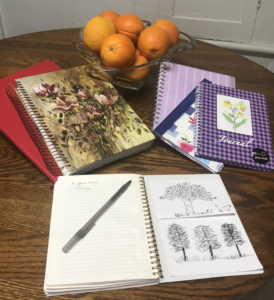Journaling Tips: a Beginner’s Guide
 10
10Apr

Years ago, my brother was living with us, and on an overwhelming day he gave me words of wisdom that I have called upon since then. I was facing a day filled with multitudes of things to do and there were so many items on the list that I was overwhelmed and felt paralyzed by the enormity of the tasks. I expressed these frustrations to my brother to which he replied, “just start.” I did, and after starting on one thing on the list, a momentum was created that carried me through the rest of the chores. Since then, when overwhelmed with tasks at hand, I find that when using the “just start” principle, things fall into place. It is the same with journaling. Perhaps there are too many things to write, or you have no idea what to write about. But, if you will just open a book, or pull out paper and a pen or pencil, the words will come.
But sometimes it is helpful to have ideas. So, the following journaling tips are just that; ideas to help after you sit down, open the book or paper and start.
6 Essential Journaling Tips to Help you Start
Report the Facts
The best-known quote from the TV series Dragnet, “just the facts, ma’am” was actually only said once in the show. But it is something to remember when writing in a journal. Report the events of the day as if you were being interviewed. Walter Cronkite served as anchorman for the CBS Evening News for 19 years and always ended his broadcast with “and that’s the way it is” followed by the date. Tell the facts or the way it is that day from your perspective.
During the pandemic everyone is currently experiencing, the following may be helpful for parents as they attempt teaching their children. This quote was found on Facebook: “A local elementary school Principal wrote this! This thing we are all a part of, it’s living history. Our children are all a part of, it’s living history. Our children are all a part of this, and it will be talked about for generations to come. Schools are closed; sports are cancelled; people are quarantined…on a Global level. The best thing your children can do is to keep a journal over the next 5+ weeks. Handwritten, typed, in photographs or drawings…record events, day to day activities, fears and feelings. Let them make a video journal if that’s the media they prefer. As parents, let them interview you, be a part of it. When it’s all over, save it/store it in a safe place for them. They will share this with their children and grandchildren. Help them create a tangible, primary source of their own history.”
And now you Know the Rest of the Story
Paul Harvey was known for his week day radio program titled “the rest of the story.” He started by telling an interesting story which inevitably had a surprise ending when he revealed the identity of the story’s main character. Write about your experiences of the day, week, month or year which may be humorous or embarrassing; something that will surprise the reader that it was actually you.
Different Types of Journals
You may want to keep a journal which covers a specific topic.
- A gratitude journal records everything you are grateful for that day. Express gratitude for
 members of your family and why you love them.
members of your family and why you love them. - A dream journal records dreams of the night (or day). Sometimes they are nonsensical and silly, sometimes adventurous and sometimes meaningful. Record your dreams and analyze the ones which may seem meaningful, perhaps using scriptures to help with the analyzation. Use the nonsensical and adventurous ones as a springboard for a story to tell children or grandchildren.
- A venting journal can be therapeutic in recording frustrations of the day or even frustrations with other people. When you don’t have a trusted friend to confide in, use a journal as a means to get thoughts and emotions out on the table, so to speak, without offending anyone.
- A miracle journal can record every day miracles, big or small. Looking for and recording these miracles helps direct our thinking into positive ways.
- A scripture journal is a good place to record musings and insights gained while studying the scriptures.
- A travel journal helps while on a vacation. Even a small record of what occurred each day will help when the trip is over and memories fade. My mother and I took what we termed, “The Grand Adventure” last year as we drove from Utah to the East coast and back visiting family history sites. Because I had written in my journal each day, I was able to put together a story with photos for my mother for Christmas.
Of course, any of these ideas can also be incorporated into a regular journal entry.
What if I Can’t Think of Anything to Write
Perhaps nothing of the day feels interesting to write about and you have no stories to tell. Sometimes it is helpful to have “prompts” when writing in a journal. These prompts or questions will reveal some of your personality to future readers (if that is your intention) or help you review important events in your life.
- FamilySearch has a site dedicated to writing your story. There are several categories with many questions included in each one. Once logged into FamilySearch, click on Activities and then “Record My Story.”
- On the Develop Good Habits website is an article titled, “100 Journaling Questions and Prompts to Spark Your Creativity.”
- There are actually journals for sale which have a question a day. By googling the internet with the phrase - Question a day journal - you will find many offered.
- One fun idea could be to have family members write a list of questions they would like to know about other members of the family. Put them all in a jar or bowl and pull one out each day to write about.
- A fantastic website for kids with printables is at Journal Buddies.
What if I Don’t Really Want to Write
 There are alternatives to writing when we wish to record our thoughts or history. One way is to do a voice recording. While traveling, record your life story, or thoughts or comment on things seen. Most phones have a recording app which makes this easy in these modern days. FamilySearch has phone app and included is a feature for voice recording which may be used to have a relative talk about a photo or story.
There are alternatives to writing when we wish to record our thoughts or history. One way is to do a voice recording. While traveling, record your life story, or thoughts or comment on things seen. Most phones have a recording app which makes this easy in these modern days. FamilySearch has phone app and included is a feature for voice recording which may be used to have a relative talk about a photo or story.
Another way of journaling is to draw or paint events or places that are meaningful. Then write a short sentence about why it is important. This could especially be beneficial for children. My father was an artist and gave us paintings for Christmas. They were always of places we had visited as a family or places that meant something to him. His paintings hang in my house and are a constant visual reminder of his life and the things he loved.
Photo journaling is another way of preserving a life history. There are many on line resources for preserving photos in a way which will tell a person’s life story; past or present. Shutterfly is one such site. Others are featured in an article online titled “10 Most Popular Photo Album Websites like Shutterfly.” One friend uses Facebook as a method of journaling her family stories. Almost every day she has a story with photos of her family. At the end of each year, she has a book put together of her posts made which always involve her children.
Benefits of Journaling
From Intermountain Healthcare in Utah was found an article titled “Five Powerful Health Benefits of Journaling.” Referencing many healthy studies, it demonstrates convincingly that journaling reduces stress, improves immune function, keeps memory sharp, boosts mood, and strengthens emotional functions. Read the article for more details.
Huffpost included an article titled “10 Surprising Benefits You’ll Get From Keeping a Journal” which discussed sparking creativity, boosting self-confidence, assisting in achieving goals, and stretching your IQ and more.
There is actually a website dedicated to journal therapy: Center for Journal Therapy.
Hopefully, you are now armed with many journaling tips and ideas so you can “just start” journaling today! Price Genealogy would be pleased to help with organization of your old photos, letters, journals, etc. Call us or contact us here for a quote.
Diane
